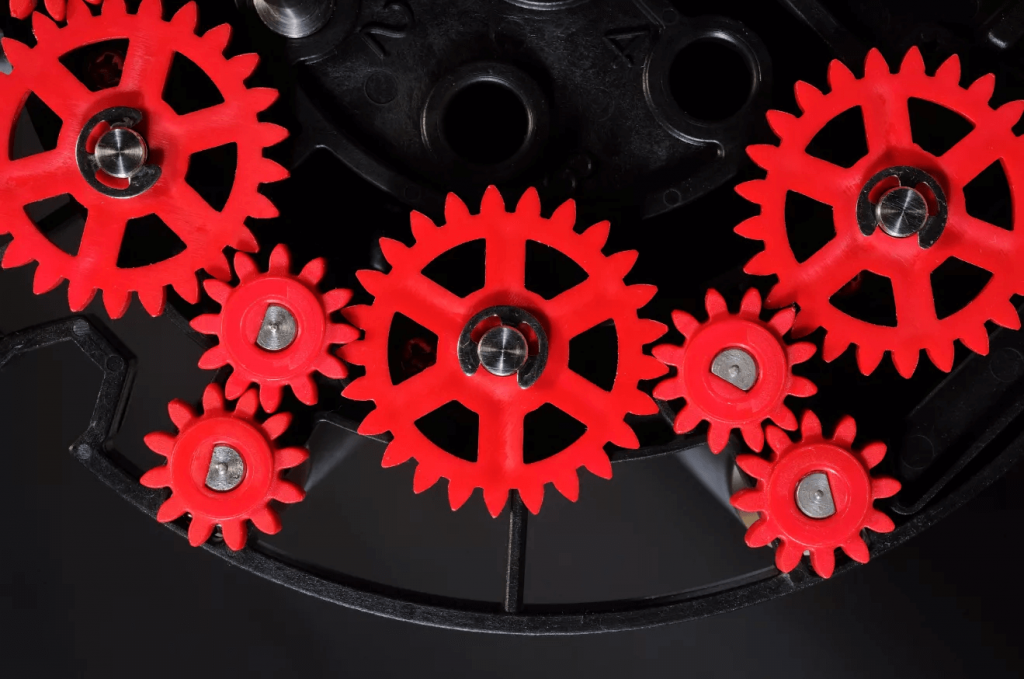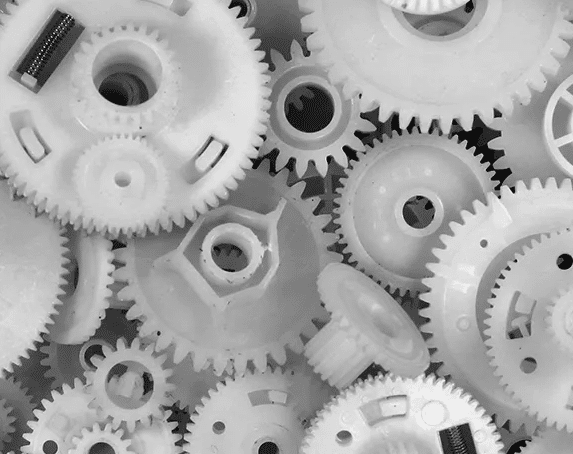Hey, need a quote for Acetal Delrin? Sign up to Jiga platform for free or talk to our sales team for an RFQ.
When it comes to choosing the right plastic for an industrial or engineering application, you have many options. When you do your research, you’ll probably encounter plastics like Acetal, POM, Nylon, UHMW, and delrin. Each of these has its own properties, pros, and cons which you should consider depending on your application.
The problem is that there’s so much information out there that it’s hard to know where to start looking. This can make the process of finding the right plastic complicated, to say the least.
Let’s face it, if you choose the wrong plastic for your requirements, you’ll end up wasting time and money because the plastic will be unsuitable for the job.
Luckily, we’re here to help and with this guide we’ll delve deeper into Acetal plastics and Delrin to show you what their qualities are, what they’re used for, and what else you can do with them. So, let’s take a look.
What Kind of Plastic is Delrin?
Delrin is the trademark name for a series of acetal resins which are semi-crystalline thermoplastic polymers also known by the abbreviation POM or polyoxymethylene.
It’s a general-purpose engineering thermoplastic. That means, it’s commonly used for parts that need to be very rigid, while also having low surface friction and good dimensional stability. Additionally, it has the ability to keep its shape and dimensions despite being exposed to changes in temperature and humidity.
These engineered plastics typically have better mechanical properties than other commonly found plastics like PVC and polyethylene. Hence, this makes them tougher and more suitable for extreme environments and industrial applications.
In simple terms, Delrin is both reliable, durable, and can be used in many applications across the globe.
What Kind of Plastic is POM Plastic?
Now that you know that Delrin is a form of POM plastic, the question is what kind of plastic is POM plastic?
Like Delrin, POM plastic is a general purpose semi-crystalline thermoplastic. It’s referred to as semi-crystalline because it has a very organized molecular structure and sharp melting points. This means that it won’t gradually soften as the temperature increases. Rather, it would stay solid until its melting point is reached when it changes quickly from solid to liquid that flows easily.
Because of this property, POM plastics are known as thermoplastics because they’re resistant to heat up until their melting point. This makes them useful to make products through injection molding, which can be used to quickly and economically produce a large number of consistently high-quality plastic parts.
Is POM Plastic Safe?
POM plastics are safe, and are approved by the FDA and USDA as a food grade product.
What is POM Plastic Used For?
Because of its similarities to Delrin, it is also used in the same applications. So, applications for POM include high performance components like gears, screws, nuts, washers, and spacers.
It’s also used in other applications like ski bindings, electronic cigarettes, watch bracelets, zippers, insulin pens, and metered dose inhalers. Also, it is commonly used in the food industry in applications like milk pumps and coffee spigots.
Is Acetal and Delrin the Same Thing?
Delrin is a type of acetal plastic and therefore largely interchangeable with other acetal plastics. As such, Delrin offers the same core benefits of other acetal plastics.
The main difference between common acetal plastics and Delrin, is that Delrin is composed as a homopolymer, or, in other words, it has a uniform crystalline structure compared to other acetal plastics that incorporate multiple subunits.
This leads to several differences between these two materials, for example:
- Hardness. Delrin does tend to have a slightly higher hardness than other acetal plastics.
- Chemical resistance. Acetal has a better resistance to the effects of hot water and strong caustic solutions when compared to Delrin.
- Temperature tolerance. Both acetal and Delrin are not designed to be used in high temperature applications and, as such, do not have high temperature tolerance.
- Flexural yield strength and tensile strength. One of the biggest differences between the two is that Delrin tends to have a significantly higher yield strength and tensile strength.
As you can see, the difference in structure does lead to better properties in some areas. Furthermore, Delrin offers slight benefits over acetal plastics when it comes to mechanical strength. Despite this, Delrin shares enough in common with other acetal plastics so that they can be used interchangeably.
What is Delrin Good For?
Delrin is an excellent choice for industrial and mechanical applications. This is especially true for applications where the parts will be exposed to moist or a wet environment. Other appropriate uses include gears, bearings, bushings, rollers, fittings, electrical insulator parts, and general CNC machining applications.

This is because of some of its exceptional key features that include:
- Rigidity
- Mechanical strength
- Lubrication properties
- Fatigue resistant
- Impact resistance
- Impervious to moisture, gas, and other chemicals
- Stable at low temperatures
- Easy to fabricate and manufacture.

Yoav A

Head of Design
Is Delrin Stronger Than Nylon?
There is an overlap of the possible industry applications for both nylon and delrin. Both have similar material properties and they both are semi-crystalline thermoplastics. For example, both are used in the manufacture of bearings, gaskets, gears, rollers, and washers.
Despite these similarities, nylon is generally stronger than delrin. Extruded nylon has a tensile strength of 12,400 PSI and cast nylon has a tensile strength of between 10,000 and 13,500 PSI. In contrast, delrin has a tensile strength of 10,000 PSI.
Is Delrin Stronger Than Aluminum?
In purely technical terms, aluminum is far stronger than delrin, but depending on the application, Delrin parts can substitute certain aluminum parts.
What is the Strongest Type of Plastic?
Polycarbonate is the strongest plastic available on the market and it’s 200 times stronger than glass. It’s also warranted against breakage or cracks. Due to its high impact strength, it is often used in construction and structures where there is snow or hail that could cause damage.
What is the Difference Between Delrin and UHMW?
UHMW stands for Ultra High Molecular Weight Polyethylene. It’s a low-cost plastic that can be used in a variety of applications and has the following benefits:
- Highly resistant to abrasion and corrosive chemicals.
- Has low friction.
- Has extremely low moisture absorption.
- It has high impact resistance.
- Suitable for machining and fabrication.
Despite the fact that it has many of the properties of delrin, it is not as strong and it is more flexible. This makes it less appropriate for several of the industrial applications that delrin is used for.
Can Delrin Plastic Be Glued?
Due to the fact that delrin and other acetal plastics have very low friction surfaces, they can be hard to penetrate and therefore difficult to glue. Typically, solvent based glues do not dissolve the surface of Delrin plastics properly. These glues work by making the two surfaces of the material “sticky”. Hence, the material becomes one bonded piece when it is allowed to dry. So, delrin cannot be effectively glued.
Can You 3D Print Delrin?
Yes, Delrin can be 3D printed. Most of its 3D printing applications are high performance engineering components like gears and bearings. For this purpose, you’ll have to use a 3D printing filament and the right equipment to do the printing.
Also, keep in mind that if delrin gets overheated it will produce formaldehyde fumes that are dangerous to inhale.
Can You Mold Delrin?
It is also possible to mold delrin and the resin is molded throughout the world in a variety of types and designs of injection equipment.
When molding delrin, it is important to use the following best practices:
- Maintain melt at optimum temperature for stability.
- Ensure gate design meets the requirements for semi-crystalline materials.
- Run the process with adequate hold pressure time for maximum part weight.
- Eject the parts when hot and let them cool outside the mold.
- If the dimensions do not fit the required tolerance, check the gate design, and process conditions.
- If the dimensions are still out of tolerance, correct the cavity dimensions.
Does Delrin Melt?
Yes, in order to mold delrin, it has to be melted. Its melting point is 178 degrees Celsius.
Can Delrin be Heated and Bent?
Yes, delrin can be heated and bent but you should be careful not to heat it too close to its melting point where it will turn into a liquid.
Is Delrin Brittle?
Because Delrin doesn’t use plasticizing for its toughness, it does not become brittle at low temperatures.
Is Delrin Expensive?
Although Delrin is relatively inexpensive, it is more expensive than other common acetal plastics.
Can You Recycle Delrin?
Yes, delrin can be recycled. Also, as a thermoplastic, the melting and setting of delrin can be repeated infinitely allowing it to be melted down and re-molded into other parts.
The Bottom Line
If you’re looking for the right plastic for a machining project or some other industrial application where you need the best properties of plastic but don’t need the full strength of a metal part, acetal and delrin may be the perfect options.
Hopefully, this guide was helpful in showing you the qualities of acetal and delrin and what they are used for.

Daniel V

